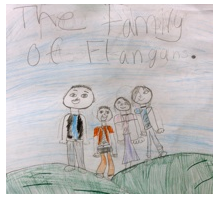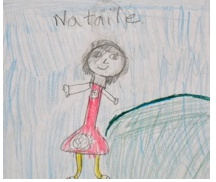Despite the fact that my predictions about the influence that Moose would be having on Natalie did not prove right, I came quite close to the truth. Although Natalie did not get into any trouble related to the prison or the criminals, her dependency on Moose is growing increasingly fast straight to the point where he tries to change her entire life by convincing her parents to send her to the school for disabled children (Choldenko Chapter 10).
One must admit, however, that I still managed to predict the dynamics in the relationships between Moose and Natalie, particularly, the fact that Moose was growing quite attached to Natalie, while the latter was clearly becoming more engaged with his life – at least, as much engaged as an autistic person can possibly be.
Defining what the friendship between the two hinged on, however, was rater easy – after all, Choldenko dropped a number of clues here and there in her novel. More to the point, she managed to create very realistic characters, whose decisions and choices were, actually, very easy to follow.
For example, Moose’s personality of a no-nonsense leader truly shines through once he shows his appreciation for family values and family members, particularly, his mother: “You get to Alcatraz by being the worst of the worst. Unless you’re me. I came here because my mother said I had to” (Choldenko Chapter 1).
The ability to communicate one’s ideas clearly and listen to others in order to acquire the necessary information is, perhaps, one of the most important skills that can be mastered by a student. Speaking and Listening Standards 3–5 (State Board 23).
According to the existing instructions, students will have to “Engage effectively in a range of collaborative discussions (one‐on‐one, in groups, and teacher‐led) with diverse partners on grade 3 topics and texts, building on others’ ideas and expressing their own clearly” (State Board 23).
The given skills can be tested with the help of a range of assessments; yet the idea of engaging two students in a discussion of a specific topic seems the most adequate means of testing their ability to acquire, process and use the information that they learn from various sources.
Therefore, it will be reasonable to suggest that the assessment of students’ skills should begin with providing them with a short text to read and then suggesting that they should discuss a specific problem related to the text in question. Thus, not only their skills of constructing a logical and well flowing argument, but also their ability to interpret the provided data will be tested.
As a text for evaluating students’ skills in reading and interpreting texts, Choldeko’s Al Capone Does My Shirts seems perfect. It has a perfect structure, dialogues leveling the lead character’s monologues, and the vocabulary is diverse enough to check whether students can understand complex concepts and the significance of stylistic choices.
The concepts, however, are never overcomplicated; Choldenko discusses rather serious issues of friendship, disability and the necessity to make choices, yet she never makes her story unnecessarily protracted.
The number of pictures is also quite sufficient for students to be able to relate the visual elements to the textual ones. More to the point, the pictures help the students dive into the novel, literally feeling its atmosphere and, thus, embracing the importance of the novel aesthetics.
The book chosen as the source for the examination material can be defined as the text for beginners, mostly because it does not contain complex concepts, ideas and vocabulary.
Being clear enough to understand for someone who already has certain reader background, it would still be inappropriate for emergent readers, since its structure and vocabulary presuppose that a student should be able to digress from the traditional three-act structure and accept a new method of telling a story.
According to the Fry Readability Formula (Cohen and Cowen 457), the text under analysis has an approximate level of readability of 9 (Fry Text Readability Assessment line 6).
In order to develop students’ creativity, a teacher must adopt unorthodox approaches towards checking their understanding of the material, as well as the concepts, ideas and dilemmas raised by the author. Therefore, the so-called “thinking process map” (Cohen and Cowen 465) must be provided to arrange the new data and at the same time teach students to be creative.
Speaking of the text in question, the ideas of friendship, choice making and the necessity to grow up and evolve should be mentioned as the key motifs. Therefore, the following visual tool can be used to help students process the concepts provided by Choldenko:
Help Natalie and Moose become better friends
Moose Flanagan. n. d.

The task provided above is admittedly hard. The students will have to use not only their information about Natalie and Moose, but also their intuitive understanding of human nature and psychology. In addition, it is important that the students should understand the specifics of Natalie’s condition. Therefore, for the assessment to be successful, it will be necessary to incorporate technology to help students navigate the new information efficiently.
For the given purpose, such a tool as the Children’s Literature Web Guide (Cohen and Cowen 498) will be of great help. By consulting it, the students will be capable of understanding the character and their motivations better.
Using the Resources for Storytellers (Children’s Literature – Resources for Storytellers para. 1–8), they will be able to understand the way in which the story allows for developing a character and, thus, will learn to use examples from the text to justify their choices and interpretations of the characters’ motivations.
Natalie’s Literary Passport

Natalie Flanagan.n. d.
Works Cited
Children’s Literature – Resources for Storytellers n. d. Web.
Choldenko, Gennifer. Al Capone Does My Shirts. London, UK: Puffin Books. 2004. Web.
Cohen, Vicki and John Cowen. Literacy for Children in an Information Age: Teaching Reading, Writing and, Thinking. Stanford, T: Cengage Learning, 2007. Print.
Fry Text Readability Assessment. n. d. Web.
Moose Flanagan. n. d. Web.
Natalie Flanagan. n. d. Web.
State Board. Standards English Language Arts 3rd – 5th Grade. 2013. PDF file.